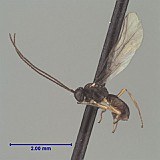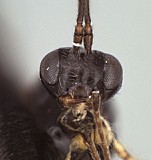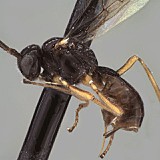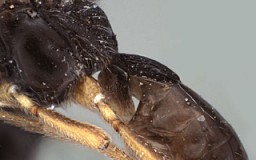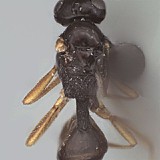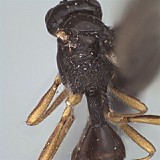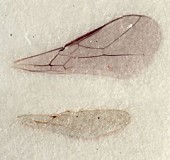Opius rugicoxis Fischer, 1969
Opius (Stomosema) rugicoxis: Fischer 1977: 223, 248-249 (key, redescription); Yu et al. 2005 (electronic catalog).
Opius rugicoxis: Wharton et al. (2012): 71-73 (diagnosis).
Fischer (1977) placed this species in his subgenus Opius (Stomosema), which he earlier (Fischer 1972) characterized on the basis of three features: absence of a mesoscutal midpit, presence of sculpture in the precoxal sulcus, and a concealed labrum. Unfortunately, the holotype has a small, shallow, but distinct midpit (Figs 5, 6) and lacks a precoxal sulcus (Fig. 3). This species would therefore key to Opius (Nosopaeopius) in Fischer (1972) and Fischer (1999). There is some faint wrinkling on the mesopleuron ventrally, but not located within a depression and not quite coincident with the position of the precoxal sulcus if it were present.
Mesosoma (Figs 3-6): Midpit small, round; pronotum not visible dorsally; notaulus weak, present as very short, weakly sculptured groove directed posterior-medially from and along edge of anterior declivity, not extending posteriorly on disc of mesoscutum; weak supra-marginal carina extending laterally from base of notaulus nearly to tegula; scuto-scutellar sulcus narrow (5-6 x wider than long), crenulate throughout; precoxal sulcus absent, thus unsculptured; hind coxa granular-rugose, hence the species name; propodeum completely granular rugose, without trace of carinae.
Wings and legs (Figs 1, 3, 7): Fore wing m-cu distinctly postfurcal; 2CUb arising below middle of first subdiscal cell; second submarginal cell long, distinctly narrowing distally; r shorter than stigma width; stigma folded, shape not readily discernible. Hind femur slender, distinctly bilobed.
Metasoma (Figs 1, 3-6): First metasomal tergite (T1) completely striate, the striae curving medially from basal-lateral area adjacent tendon attachment, obscuring dorsal-lateral and lateral carinae; dorsope absent, laterope not apparent; T1 spiracle indistinct, situated posteriad midlength of T1; T1 nearly parallel-sided, 2.25 x longer than apical width; first metasomal sternite (S1) appears fused to T1; S1 0.3 x length of T1.
There is a Cerro Troya 5 Km S. Tulcan on the Colombian border (mt top = 11,485 ft)
00degrees 44’N, 77degrees 41’W.
Type locality. Ecuador, Troya, 2900 m.
Troya, Ecuador
VI. 10-13. 65 2900m.
Luis Pena
Second label [purple]: Holotype
Third label:
Opius [female symbol]
rugicoxis
det Fischer n. sp.
Fourth label:
Type no.
659
This material is based upon work supported by the National Science Foundation under Grant Numbers DEB 0949027.
Any opinions, findings, and conclusions or recommendations expressed in this material are those of the author(s) and do not necessarily reflect the views of the National Science Foundation.

